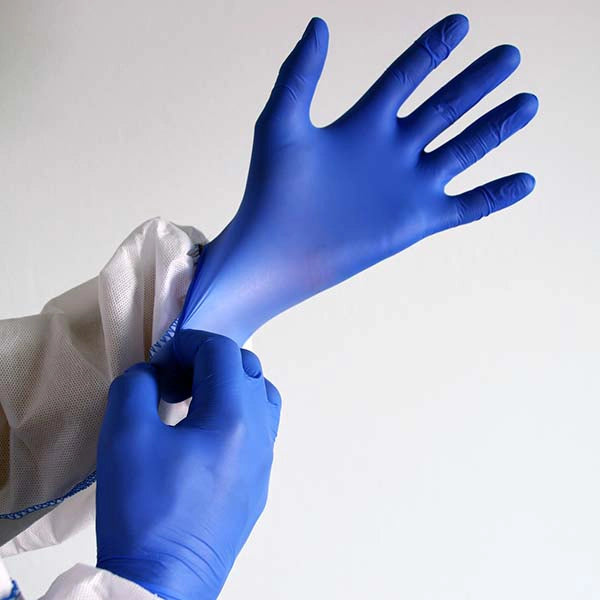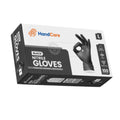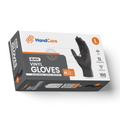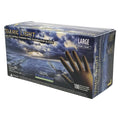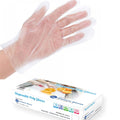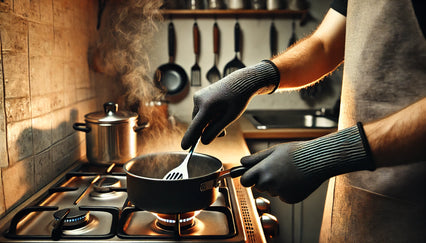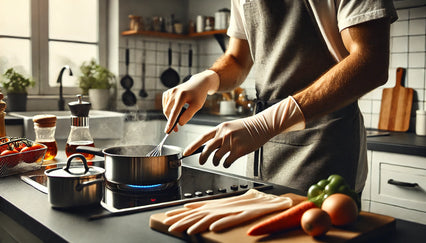When you're handling food in a commercial kitchen or at home, using the right gloves is key to ensuring food safety and preventing cross-contamination.
Food prep gloves create a barrier between your hands and the food you're preparing, protecting both you and the food from potential contaminants.
With so many types of disposable gloves available, it can be challenging to know which ones are best suited for your specific food handling needs.
What are Food Prep Gloves?
Food prep gloves are single-use, disposable gloves designed specifically for safe food handling. They serve two primary purposes: protecting the food from contamination and shielding the wearer's hands from the food and any potential hazards, such as heat or sharp objects.
These gloves are typically made from food-safe materials that meet FDA regulations, ensuring they won't leach chemicals or impart odors or flavors to the food. They are available in various sizes to ensure a snug, comfortable fit that allows for dexterity while handling food.
Examples of Food Prep Gloves
Several types of disposable gloves are commonly used in food preparation:
- Nitrile gloves: These gloves are made from synthetic rubber and are known for their durability, puncture resistance, and chemical resistance. They are an excellent choice for tasks that require a high level of dexterity, such as chopping vegetables or handling raw meat.
- Vinyl gloves: Made from PVC, vinyl gloves are a cost-effective option suitable for most food handling tasks. They offer a loose fit, making them easy to put on and take off, which is ideal for situations that require frequent glove changes.
- Latex gloves: Natural rubber latex gloves provide excellent tactile sensitivity and comfort, making them a popular choice for food handling. However, due to the risk of latex allergies, many food service establishments have moved away from using latex gloves.
- Polyethylene gloves: These lightweight, disposable gloves are designed for light-duty tasks, such as assembling sandwiches or handling baked goods. They are often used in situations where gloves need to be changed frequently, as they are inexpensive and easy to remove.
How to Choose the Best Food Prep Gloves
When selecting the best gloves for food preparation, consider the following factors:
- Material: Choose gloves made from food-safe materials that won't leach chemicals or impart odors or flavors to the food. Nitrile, vinyl, and polyethylene are popular choices for food handling.
- Durability: Opt for gloves that can withstand the demands of your specific food prep tasks. Nitrile gloves are known for their puncture resistance and durability, making them suitable for tasks like chopping and slicing.
- Fit and comfort: Select gloves that fit snugly and comfortably, allowing for easy movement and dexterity. A good fit also reduces the risk of gloves slipping or tearing during use.
- Powder-free: Choose powder-free gloves to minimize the risk of contamination and prevent allergic reactions in both food handlers and consumers.
- Allergies: If you or your staff have latex allergies, avoid latex gloves and opt for alternatives like nitrile or vinyl.
- Task-specific requirements: Consider the specific tasks you'll be performing and choose gloves accordingly. For example, polyethylene gloves are ideal for light-duty tasks like making sandwiches, while nitrile gloves are better suited for tasks requiring more durability and chemical resistance.
Food Safety Tips for Using Disposable Gloves
To ensure proper food safety when using disposable gloves, follow these guidelines:
- Wash hands: Always wash your hands thoroughly with soap and water before putting on a new pair of gloves.
- Change gloves frequently: Change your gloves whenever they become torn, soiled, or contaminated, and when switching between different tasks or food items.
- Avoid cross-contamination: Never reuse disposable gloves, and avoid touching non-food surfaces like phones or door handles while wearing gloves meant for food handling.
- Proper glove removal: Remove gloves carefully to avoid contaminating your hands or the surrounding area. Grab the cuff of one glove and pull it off inside-out, then use the inside-out glove to remove the other glove, turning it inside-out as well.
- Dispose of used gloves properly: Discard used gloves in a designated trash bin and avoid leaving them on food preparation surfaces or other areas where they could cause contamination.
Wearing gloves doesn't replace the need for proper handwashing. Gloves are an additional barrier to help prevent the spread of bacteria and other contaminants during food preparation.
5 Best Gloves for Food Prep
When it comes to food preparation, selecting the right gloves is crucial for ensuring safety, hygiene, and efficiency in the kitchen. Whether you’re a professional chef or a home cook, using gloves that are designed specifically for food handling can help prevent cross-contamination and protect your hands from potential hazards.
Below are five of the best glove options available, each suited to different food prep tasks. These selections not only meet high standards for safety and comfort but also offer excellent value, making them ideal choices for any kitchen environment.
1. HandCare Black Nitrile Gloves - Exam Grade, Powder Free (6 Mil)
These gloves are made from high-quality nitrile, offering superior durability and puncture resistance. With a thickness of 6 Mil, they provide an excellent barrier against harmful substances, including chemicals and pathogens, making them ideal for high-risk food prep tasks. The gloves are also powder-free, reducing the risk of contamination and making them suitable for handling various food items without leaving any residue. The snug fit ensures that the gloves remain in place, providing the wearer with enhanced dexterity and control.
👉 Shop HandCare Black Nitrile Gloves and save up to 50%
- Best For: These gloves are perfect for tasks that require precision, such as chopping vegetables or working with raw meat. Their strong resistance to punctures and chemicals also makes them suitable for handling hot ingredients and working with sharp tools.
2. HandCare Blue Nitrile Gloves - Exam Grade, Powder Free (4 Mil)
HandCare’s Blue Nitrile Gloves are a slightly thinner option at 4 Mil thickness, which strikes a balance between protection and tactile sensitivity. This makes them an excellent choice for tasks that require a high level of touch sensitivity, such as preparing delicate food items. The gloves are also powder-free, ensuring that no residue is left on the food, which is particularly important when dealing with fresh produce or baked goods. Their blue color makes them easily visible, adding an extra layer of safety in a busy kitchen environment.
👉 Shop HandCare Blue Nitrile Gloves and save up to 50%
- Best For: These gloves are ideal for medium-duty food prep tasks like handling baked goods, mixing ingredients, or preparing salads. Their light weight and comfortable fit make them suitable for prolonged use without causing hand fatigue.
3. HandCare Black Vinyl Gloves - Powder Free (3 Mil)
The HandCare Black Vinyl Gloves are designed to be a cost-effective solution for food handling. Made from durable PVC, these gloves provide a balance of protection and flexibility, allowing for comfortable use during food prep. At 3 Mil thickness, they are easy to put on and take off, which is essential in environments where frequent glove changes are required. The gloves are also powder-free, minimizing the risk of cross-contamination in food preparation areas.
👉 Shop HandCare Black Vinyl Gloves and save up to 50%
- Best For: These gloves are best suited for general food handling tasks, such as making sandwiches, assembling salads, or serving ready-to-eat foods. Their cost-effectiveness makes them an ideal choice for kitchens where gloves need to be changed often.
4. Dark Light Black Nitrile Gloves - Exam Grade, Powder Free (9 Mil)
Dark Light Black Nitrile Gloves are designed for the toughest food prep tasks. With a thickness of 9 Mil, these gloves offer maximum protection against punctures, tears, and chemical exposure. They are particularly suited for tasks involving the handling of raw meat, cutting with sharp tools, or working with harsh cleaning chemicals. Despite their thickness, these gloves maintain a high level of dexterity, allowing for precise control in detailed tasks. The powder-free design further ensures that no contaminants are introduced into the food.
👉 Shop Dark Light Black Nitrile Gloves and save up to 50%
- Best For: These gloves are ideal for heavy-duty tasks, such as butchering meat, cleaning, or any application where maximum protection is required. Their robust construction makes them reliable for extended use in demanding kitchen environments.
5. Disposable Poly Gloves Powder Free Multi-Purpose Polyethylene Gloves
These Disposable Poly Gloves are made from lightweight polyethylene, making them an economical choice for food prep tasks that require frequent glove changes. Their loose fit allows for easy donning and removal, which is especially useful in fast-paced environments. Despite their lightweight design, these gloves provide an effective barrier against contaminants, making them suitable for handling a variety of food items. They are powder-free, ensuring that no residue is left behind, which is essential when handling delicate or ready-to-eat foods.
👉 Shop Disposable Poly Gloves Powder Free Multi-Purpose and save up to 50%
- Best For: These gloves are perfect for light-duty tasks such as assembling sandwiches, handling baked goods, or preparing salads. Their low cost and ease of use make them ideal for kitchens where speed and efficiency are prioritized.
Benefits of Using Food Prep Gloves
Food prep gloves offer several advantages that make them an indispensable tool in any kitchen.
Prevents Cross-Contamination
Cross-contamination occurs when harmful bacteria or allergens are unintentionally transferred from one food item to another. Gloves act as a barrier between your hands and the food you're preparing, significantly reducing the risk of foodborne illnesses caused by cross-contamination.
When you wear gloves, you minimize the chances of bacteria from your hands coming into contact with food, and you also prevent any contaminants on the food from reaching your skin. This is especially important when handling raw meats, as they can harbor dangerous bacteria like Salmonella or E. coli.
Protects the Wearer
In addition to keeping food safe, gloves also protect your hands from various hazards in the kitchen. They shield your skin from hot surfaces, sharp objects like knives or graters, and harsh cleaning chemicals that could cause irritation or injury.
Wearing gloves while chopping spicy ingredients, such as jalapeños or hot peppers, prevents the oils from irritating your skin or accidentally transferring to your eyes. Gloves also provide a barrier against stains from food dyes or strong odors that can linger on your hands after cooking.
Promotes Hygiene
Disposable food prep gloves encourage frequent glove changes, which helps maintain a clean and hygienic food preparation environment. Guidelines for proper use of gloves in food service recommend changing gloves whenever they become soiled, torn, or when switching between tasks.
This practice ensures that any contaminants picked up during one task are not transferred to another food item or surface. Frequent glove changes also remind you to wash your hands regularly, further promoting good hygiene habits in the kitchen.
Complies with Food Safety Regulations
Using gloves in food service helps meet health department requirements and complies with food safety regulations. Many local health codes mandate the use of gloves when handling ready-to-eat foods to minimize the risk of foodborne illnesses.
Failing to follow these regulations can result in citations or fines for your establishment. By consistently wearing gloves during food preparation, you demonstrate a commitment to food safety and protect your business from potential legal issues.
How to Choose the Right Food Prep Gloves
Selecting the appropriate gloves for your food preparation tasks is essential to maintain food safety and protect your hands from potential hazards. When choosing gloves, consider the specific tasks you'll be performing, as different glove materials are better suited for certain applications.
For example, nitrile gloves are an excellent choice for heavy-duty tasks like handling raw meat or cleaning with harsh chemicals. These gloves are durable, puncture-resistant, and provide a high level of protection against contaminants. On the other hand, poly gloves are ideal for light-duty tasks such as assembling sandwiches or handling baked goods. They are lightweight, inexpensive, and easy to change frequently.
Proper fit is another crucial factor when selecting food prep gloves. Gloves that are too loose can slip off easily, increasing the risk of contamination, while gloves that are too tight can restrict movement and cause discomfort. Choose gloves that fit snugly on your hands, allowing you to maintain dexterity and grip while working with food.
If you or your staff have latex allergies, it's essential to opt for latex-free gloves to prevent any adverse reactions. Nitrile and vinyl gloves are popular alternatives that provide similar levels of protection without the risk of allergic reactions.
When purchasing food prep gloves, always look for options made from FDA-approved, food-grade materials. These gloves are designed to be safe for direct contact with food and won't leach any harmful chemicals or impart unwanted odors or flavors. Food-safe gloves are typically made from materials like nitrile, vinyl, or polyethylene, which have been rigorously tested and approved for use in food service settings.
Where to Buy the Best Gloves for Food Prep?
Investing in the right food prep gloves not only helps you comply with food safety regulations but also demonstrates your commitment to providing safe, high-quality food to your customers. By taking the time to choose gloves that meet your specific needs, you can create a more efficient and hygienic food preparation environment.
Choosing the right gloves for food prep is essential for maintaining food safety and protecting your hands. gloves.com offers a wide selection of high-quality, FDA-approved gloves that cater to various food handling needs, ensuring you find the perfect fit for any task.
Shop the Best Gloves for Food Prep and save up to 50%

